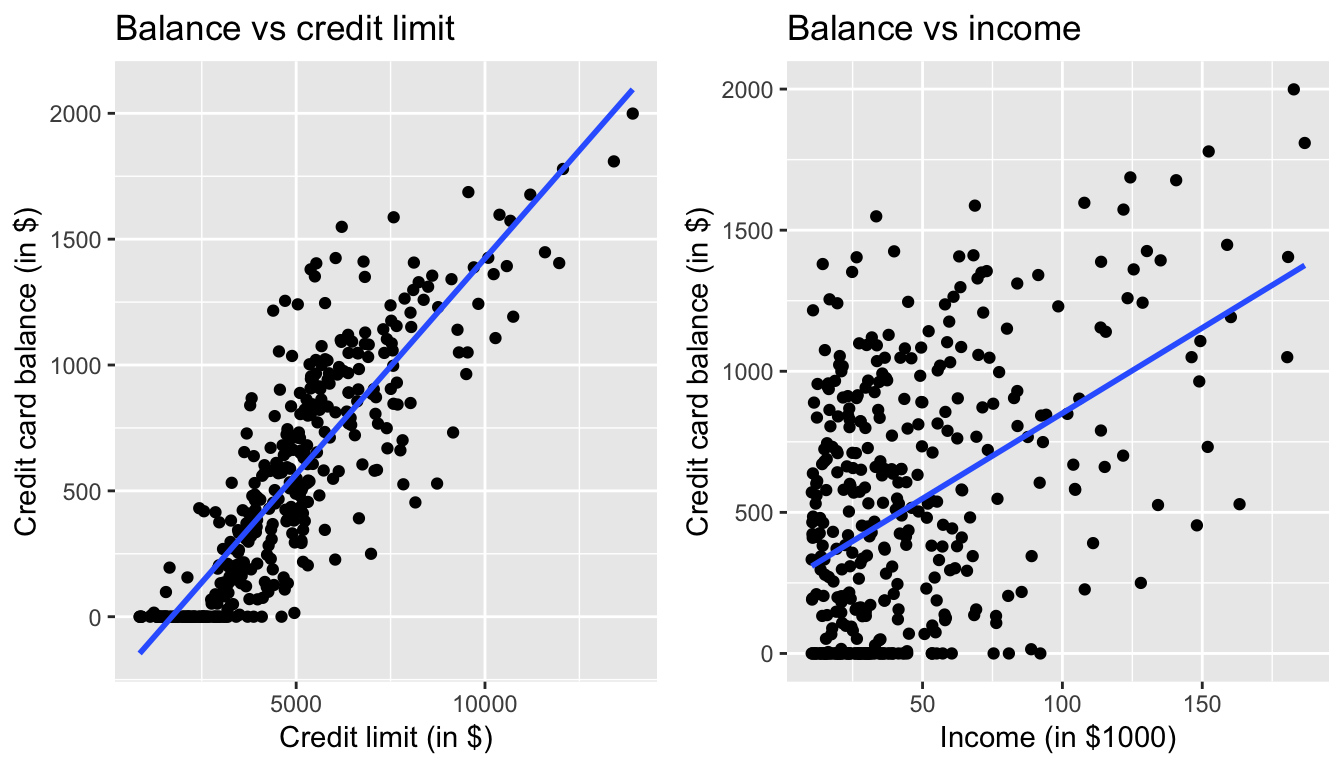class: center, middle, inverse, title-slide # Week 08 - Regression ## Multivariate Models, Statistical Control and Standardised Coefficients <html> <div style="float:left"> </div> <hr color='#EB811B' size=1px width=800px> </html> ### Danilo Freire ### 11th March 2019 --- <style> .remark-slide-number { position: inherit; } .remark-slide-number .progress-bar-container { position: absolute; bottom: 0; height: 6px; display: block; left: 0; right: 0; } .remark-slide-number .progress-bar { height: 100%; background-color: #EB811B; } .orange { color: #EB811B; } </style> # Today's Agenda .font150[ * Brief recap of multivariate linear models * Statistical controls * Standardised coefficients ] --- # Multivariate Linear Models .font150[ * We can include more than one predictor in the regression model: `lm(Y ~ X1 + X2 + ... + Xn, data = yourdataset)` * Principle of regression model stays the same: to draw the best fitting line through a cloud of points (now in multiple dimensions) ] --- # Credit Limit, Balance and Income .center[] --- # Multivariate Linear Model .center[] --- # Interpretation .font150[ * `\(Y = \alpha + \beta_1 X_1 + \beta_2 X_2 + ... + \beta_n X_n + \epsilon\)` * `\(\alpha =\)` intercept, the value of `\(Y\)` when _all_ `\(X\)` variables are zero * `\(\beta_n =\)` the slope of predictor `\(X_n\)` * `\(\beta_n =\)` predicted change in `\(\hat{Y}\)` when `\(X_n\)` increases by 1 unit _and all other predictors are held constant_ ] --- # Statistical Control .font150[ * We include more variables in a regression also because we want to .orange[control for confounders] * We hold constant factors that we believe are also associated with `\(Y\)` * We can then _dissociate_ what can be explained by `\(X_1\)` from what can be explained by `\(X_2\)` * We have "more realistic" estimates * Example: impact of GDP on child mortality when political regime doesn't change ] --- # Child Mortality .font120[ ```r mortality <- read.csv("https://raw.githubusercontent.com/pols1600/pols1600.github.io/master/datasets/prediction/bivariate_data.csv") mortality <- subset(mortality, subset = Year == 2010) names(mortality) ``` ``` ## [1] "X" "Entity" "Year" "Country.code" ## [5] "GDP" "PolityIV" "Child.Mortality" ``` ```r bivar <- lm(Child.Mortality ~ log(GDP), data = mortality) multiple <- lm(Child.Mortality ~ log(GDP) + PolityIV, data = mortality) coef(bivar) ``` ``` ## (Intercept) log(GDP) ## 276.58162 -26.12717 ``` ```r coef(multiple) ``` ``` ## (Intercept) log(GDP) PolityIV ## 277.845620 -25.641789 -1.029062 ``` ] --- # Adjusted R-Squared .font150[ * As we saw last week, `\(R^2\)` is not a very good measure of model fit * The more predictors you add to the model, the higher the `\(R^2\)` * Adjusted `\(R^2\)` will equal `\(R^2\)` for one predictor variable, but lower if you add more * Adjusted `\(R^2\)` "penalises" you for adding the extra predictor variables that don't improve the existing model ] --- # Adjusted R-Squared .font150[ ```r summary(bivar)$r.squared ``` ``` ## [1] 0.586953 ``` ```r summary(multiple)$r.squared ``` ``` ## [1] 0.6113747 ``` ```r summary(multiple)$adj.r.squared ``` ``` ## [1] 0.6061582 ``` ] --- # Standardised Coefficients .font150[ * Regression coefficients cannot be directly compared as independent variables have different scales (dollars, years, etc) * One way to make them more comparable is to standardise the variables * You already know how to standardise variables: _z-score_ * (value - mean)/standard deviation * So the variables would have a mean of zero and a standard deviation of 1 ] --- # Standardised Coefficients .font150[ * When continuous variables are standardised, the coefficients indicate _one standard deviation change_ * We can compare 1 sd in all factors * We use the `scale()` command to standardise factors * The intercept _is still_ the value of `\(\hat{Y}\)` when all predictors equal zero * .orange[But now zero is the mean value of the predictors] ] --- # Standardised Coefficients .font120[ ```r mean(mortality$PolityIV, na.rm = TRUE) ``` ``` ## [1] 3.858025 ``` ```r sd(mortality$PolityIV, na.rm = TRUE) ``` ``` ## [1] 6.263239 ``` ```r mean(mortality$GDP, na.rm = TRUE) ``` ``` ## [1] 18189.2 ``` ```r sd(mortality$GDP, na.rm = TRUE) ``` ``` ## [1] 19058.94 ``` ] --- # Standardised Coefficients .font120[ ```r mortality$sd.polity.iv <- scale(mortality$PolityIV) mortality$sd.gdp <- scale(mortality$GDP) summary(mortality$sd.gdp) ``` ``` ## V1 ## Min. :-0.9246 ## 1st Qu.:-0.7402 ## Median :-0.3485 ## Mean : 0.0000 ## 3rd Qu.: 0.4939 ## Max. : 5.4221 ## NA's :9 ``` ```r sd(mortality$sd.gdp, na.rm = TRUE) ``` ``` ## [1] 1 ``` ] --- # Standardised Coefficients .font120[ ```r unstd <- lm(Child.Mortality ~ GDP + PolityIV, data = mortality) std <- lm(Child.Mortality ~ sd.gdp + sd.polity.iv, data = mortality) coef(unstd) ``` ``` ## (Intercept) GDP PolityIV ## 68.029245081 -0.001215594 -1.715946970 ``` ```r coef(std) ``` ``` ## (Intercept) sd.gdp sd.polity.iv ## 39.29839 -23.16794 -10.74739 ``` ] --- class: inverse, center, middle # Questions? <html><div style='float:left'></div><hr color='#EB811B' size=1px width=720px></html> --- class: inverse, center, middle # See you on Wednesday! <html><div style='float:left'></div><hr color='#EB811B' size=1px width=720px></html>